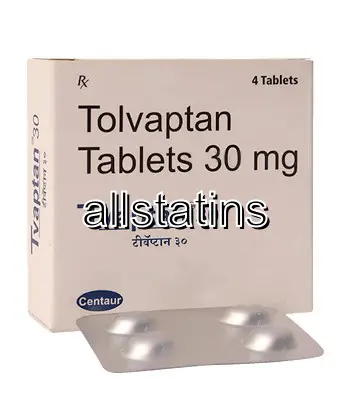| Package | Dosage | Price | Price per Dose | |
|---|---|---|---|---|
| Dosage: 15mg | ||||
| 180 pill | 15mg | $1,905.21 | $10.58 | |
| 120 pill | 15mg | $1,291.66 | $10.76 | |
| 90 pill | 15mg | $984.89 | $10.94 | |
| 60 pill | 15mg | $667.35 | $11.12 | |
| 30 pill | 15mg | $339.05 | $11.30 | |
| 20 pill | 15mg | $229.61 | $11.48 | |
| 10 pill | 15mg | $116.59 | $11.66 | |
| Dosage: 30mg | ||||
| 120 pill | 30mg | $1,682.75 | $14.03 | |
| 90 pill | 30mg | $1,284.49 | $14.28 | |
| 60 pill | 30mg | $871.87 | $14.53 | |
| 30 pill | 30mg | $439.51 | $14.66 | |
| 20 pill | 30mg | $295.99 | $14.80 | |
| 10 pill | 30mg | $148.88 | $14.89 | |

Tolvaptan Description
Introduction to Tolvaptan
Tolvaptan is a prescription medication used primarily to treat certain conditions related to water retention and electrolyte imbalance. It belongs to a class of drugs known as vasopressin receptor antagonists. This medication is specially formulated to help regulate the body's water balance by inhibiting the action of vasopressin, a hormone that promotes water reabsorption in the kidneys. As a result, Tolvaptan helps increase urine production, facilitating the removal of excess water from the body.
Uses and Medical Indications
Tolvaptan is mainly prescribed for the treatment of autosomal dominant polycystic kidney disease (ADPKD). This condition causes cyst formation in the kidneys, leading to an increase in kidney size and decline in function over time. By slowing the growth of cysts, Tolvaptan aims to preserve kidney function and delay the need for dialysis or transplantation. Additionally, it can be used for treating hyponatremia, a condition characterized by low sodium levels in the blood, especially when caused by syndrome of inappropriate antidiuretic hormone secretion (SIADH).
How Tolvaptan Works
The active mechanism of Tolvaptan involves blocking vasopressin V2 receptors in the kidneys. Vasopressin normally signals the kidneys to retain water when the body is dehydrated or needs to maintain fluid balance. When these receptors are blocked, water reabsorption decreases, leading to increased urination and a reduction in fluid retention. This process helps correct hyponatremia and control cyst growth in ADPKD.
Potential Benefits
Many patients experience significant relief from symptoms related to water retention with Tolvaptan. The medication can improve quality of life by reducing swelling, decreasing blood pressure, and alleviating related discomfort. Its role in slowing the progression of kidney disease makes it a valuable option for patients with ADPKD. However, the benefits depend on careful monitoring and adherence to prescribed doses.
Possible Side Effects and Risks
Despite its effectiveness, Tolvaptan may cause side effects in some users. Common adverse reactions include increased thirst, dry mouth, increased urination, dizziness, and nausea. More serious concerns involve dehydration and liver injury, which require careful monitoring by healthcare providers. Liver function tests are often performed regularly during treatment due to the potential for hepatotoxicity. It is crucial for users to report any unusual symptoms or signs of liver trouble, such as jaundice or abdominal pain, to their doctor immediately.
Precautions and Considerations
Before starting Tolvaptan, patients should inform their healthcare provider about any pre-existing liver conditions, electrolyte abnormalities, or other health issues. It is important to follow dosing instructions carefully to avoid the risks of overcorrection of sodium levels or dehydration. During treatment, regular blood tests help ensure safety and effectiveness. Patients are advised to maintain adequate hydration and to avoid activities that may increase dehydration risk.
Conclusion
Tolvaptan is a potent medication that can offer significant benefits for specific medical conditions such as ADPKD and hyponatremia. Its ability to regulate water balance makes it a unique choice in its therapeutic area. However, due to potential side effects and the need for close monitoring, it should only be used under the supervision of a healthcare professional. Proper management ensures the medication's benefits outweigh its risks, leading to better health outcomes for patients.
